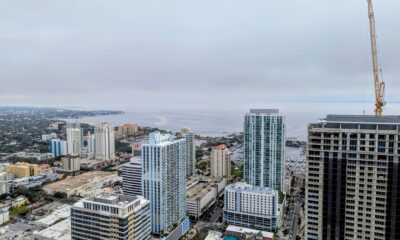St. Pete’s stormwater bill could top $1 billion

City officials are putting the finishing touches on St. Petersburg’s long-awaited Stormwater Master Plan that includes roughly $1 billion in recommended projects through 2050.
City council members heard the latest update at a July 25 Committee of the Whole meeting. It largely mirrored a May 2023 presentation that included 76 projects totaling $760 million.
The expansive plan incorporates new modeling technology, sea level rise and rainfall data, stakeholder feedback and policy recommendations to reduce developmental impacts. Councilmember Lissette Hanewicz questioned how the city would afford its recommendations.
“The funding is not going to be there for all these projects for 2050,” Hanewicz said. “We’re not even talking about seawalls … and there is going to be a cost associated with storm surge at some point, too.”
Brejesh Prayman, engineering and capital improvements director, provided the latest update on a process that began in April 2021. He explained that despite the plan’s scope, it does not include an upcoming seawall vulnerability study or storm surge mitigation efforts – like installing tidal backflow preventers.
The overarching goal is to improve water quality and reduce the frequency and intensity of flooding. The city completed its last Stormwater Master Plan in 1994.
Claude Tankersley, public works administrator, said his department received $17 million in the current budget and requested $25 million in fiscal year 2025. Hanewicz asked for the annual cost of completing the plan’s recommended projects through the Vision 2050 planning horizon.
“If we’re going to be spending a billion dollars on stormwater for a 20-year period, we should be spending $50 million a year,” Tankersley replied after some thought.
Prayman noted that the city completed just a third of the 1994 plan’s recommendations. Officials intend for the latest iteration to be a living document that evolves as new data becomes available.
The committee unanimously approved sending the Stormwater Master Plan to an Aug. 15 city council meeting for adoption. Prayman said administrators could create another list of related projects.
“And you can have a big storm event, and it changes everything again,” Hanewicz said. “There is still a lot of work to be done and a lot of challenges.”

A recommended project example that removes 46 structures from the 100-year floodplain. Screengrab, city documents.
The complex, iterative process utilizes new modeling technology that has paid dividends. Praymen said the city has spent $3 million developing the plan, which has already saved the city $15 million on three projects through grant awards.
Those include installing a Salt Creek outfall pump station and conveyance enhancements totaling over $24 million and a $3.5 million Barlett Lake improvements project. Prayman said the city would spend less than initially expected on at least half of the plan’s recommended initiatives.
He said officials would also look to combine stormwater and infrastructure improvements. Prayman said that would minimize construction and utility rate impacts.
Administrators integrate historical environmental data with extensive public feedback with new LiDAR (light detection and ranging) modeling. They then rank a project according to criticality and the number of structures it will remove from the city’s 100-year floodplain.
Prayman said the laser-guided measuring system can predict flooding impacts with pinpoint accuracy. The 1994 plan modeled 1,186 stormwater subbasins. That number has since soared to 12,628.
Prayman said the city could use the software to warn residents of impending flooding via text message. However, officials must first clean the stormwater system, strategically place new sensors and discern program parameters.
The city has hired a National Pollutant Discharge Elimination System (NPDES) coordinator and is implementing “critical health and safety” projects. Prayman said administrators are already addressing the top-ranked initiatives.
They have also selected an architectural and engineering firm to oversee a system-wide condition assessment to develop an asset management program. Prayman said that would reduce the risk of pipes – some date back to the 1920s and 1950s – collapsing and other drainage issues.
Elizabeth Abernethy, planning and development services director, said the Stormwater Master Plan would improve St. Petersburg’s community rating system. That would reduce flood insurance rates.

Dirt, oil and other pollutants from construction sites combine with runoff and reach the stormwater system and local waterways. Screengrab, city documents.
While the council will formally adopt the initiative before the next audit in August, they must still incorporate new state regulations and code revisions. Recently enacted legislation mandates developers to reduce total phosphorous and nitrogen counts by 80% and 45%, respectively, to meet stormwater permitting requirements by December 2025.
“You’re going to have to have more time of attenuation – holding that water onsite to reduce your nutrient loading,” Prayman explained. “Because you have to treat so much nutrient loading, you have to slow down the amount of discharge you have in your development.”
Administrators have recommended nearly 30 city code updates regarding enhanced stormwater policy enforcement. Those address seawall protection, marina pollution, canal maintenance, construction site discharge, drainage and surface water management and fee collection.
Prayman said the new rules would typically apply to multifamily and commercial developers. Councilmember Copley Gerdes said he would like to track repeat offenders.
Council members will continue discussing the code revisions and vote on adoption in the fall. Abernethy said she would create a business impact statement highlighting additional associated costs.








Rebecca A Richardson
July 30, 2024at8:24 pm
Amen!!!
Velva Lee Heraty
July 30, 2024at3:04 pm
Where were all these city thinkers when the last administration granted permits and easements so recklessly? Where was everyone when it was OKed to build the monster now looming over our downtown? Where are the decision makers who lacked such foresight we can’t even swim in our polluted bay? Can we please make a sweep of all these short-sighted city administrators and staff? It’s really time to start fresh and start smart.